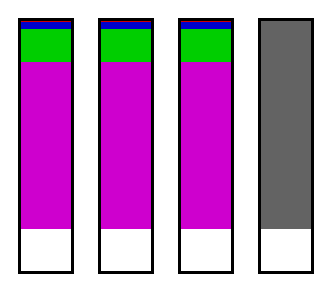[ The PC Guide | Systems and Components Reference Guide | Hard Disk Drives | Hard Disk Performance, Quality and Reliability | Redundant Arrays of Inexpensive Disks (RAID) | RAID Levels | Single RAID Levels ]
RAID Level 3
Common Name(s): RAID 3. (Watch out for some companies that say their products implement RAID 3 when they are really RAID 4.)
Technique(s) Used: Byte-level striping with dedicated parity.
Description: Under RAID 3, data is striped across multiple disks at a byte level; the exact number of bytes sent in each stripe varies but is typically under 1024. The parity information is sent to a dedicated parity disk, but the failure of any disk in the array can be tolerated (i.e., the dedicated parity disk doesn't represent a single point of failure in the array.) The dedicated parity disk does generally serve as a performance bottleneck, especially for random writes, because it must be accessed any time anything is sent to the array; this is contrasted to distributed-parity levels such as RAID 5 which improve write performance by using distributed parity (though they still suffer from large overheads on writes, as described here). RAID 3 differs from RAID 4 only in the size of the stripes sent to the various disks.
|
This illustration shows how files of different sizes
are distributed |
Controller Requirements: Generally requires a medium-to-high-end hardware RAID card.
Hard Disk Requirements: Minimum of three standard hard disks; maximum set by controller. Should be of identical size and type.
Array Capacity: (Size of Smallest Drive) * (Number of Drives - 1)
Storage Efficiency: If all drives are the same size, ( (Number of Drives - 1) / Number of Drives).
Fault Tolerance: Good. Can tolerate loss of one drive.
Availability: Very good. Hot sparing and automatic rebuild are usually supported by controllers that implement RAID 3.
Degradation and Rebuilding: Relatively little degrading of performance if a drive fails. Rebuilds can take many hours.
Random Read Performance: Good, but not great, due to byte-level striping.
Random Write Performance: Poor, due to byte-level striping, parity calculation overhead, and the bottleneck of the dedicated parity drive.
Sequential Read Performance: Very good.
Sequential Write Performance: Fair to good.
Cost: Moderate. A hardware controller is usually required, as well as at least three drives.
Special Considerations: Not as popular as many of the other commonly-implemented RAID levels. For transactional environments, RAID 5 is usually a better choice.
Recommended Uses: Applications working with large files that require high transfer performance with redundancy, especially serving or editing large files: multimedia, publishing and so on. RAID 3 is often used for the same sorts of applications that would typically see the use of RAID 0, where the lack of fault tolerance of RAID 0 makes it unacceptable.
![]() Next: RAID Level 4
Next: RAID Level 4
| The PC Guide
(http://www.PCGuide.com) Site Version: 2.2.0 - Version Date: April 17, 2001 © Copyright 1997-2004 Charles M. Kozierok. All Rights Reserved. |
Not responsible for any loss resulting from the use of this site. Please read the Site Guide before using this material. |
